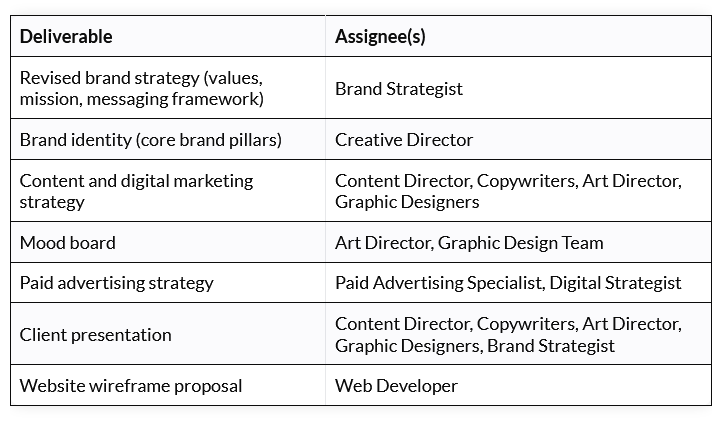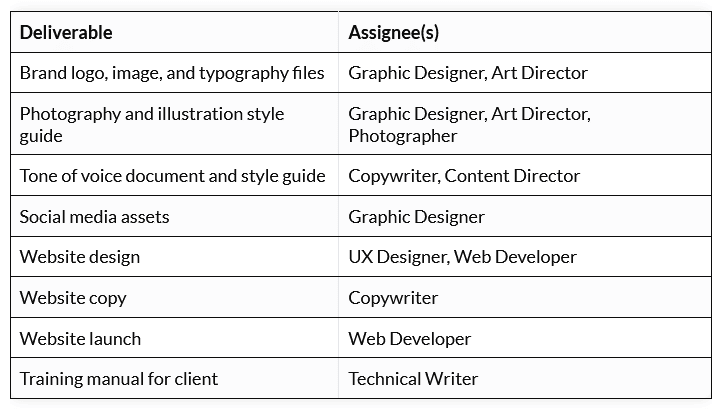Project Deliverables: What They Are and How to Scope Them
You’ve likely heard the word deliverables get thrown around. You know your projects include a list of them, that your team members are responsible for producing them, and that they’re crucial to the success of the business. But do you and your team really understand what they are or how to craft them?
In this post, we’ll present a clear definition for deliverables, show you how you can define them in a way that makes your projects run smoother and more efficiently, and give you concrete examples from a major project.
What are project deliverables?

Project managers discuss project deliverables constantly, but when it comes time to define the term it’s surprisingly difficult for even the most experienced PMs. Even though deliverables are an essential part of project management.
Put simply, a deliverable is a product or service created or performed in the completion of a project. When you consider a project, there are elements of input (what goes into the project such as time, resources, information, etc.) and elements of output — the deliverables.
For example, if one task within a project is to create a blog post, the deliverables could include a brief (provided by the stakeholder or requester), blog post copy (to be completed by a writer), and blog post image files (to be delivered by a graphic designer).
What are key deliverables?
While you may hear the term ‘key deliverables’ used interchangeably with ‘deliverables’, it’s helpful to think of these as separate concepts. Although a deliverable can be produced in connection to a project, key deliverables are the main outputs set and produced in the completion of a project. The overall project might have a list of 30 deliverables altogether, but perhaps just 5 key deliverables.
Deliverable vs. objective vs. milestone
Deliverables aren’t the only thing you’re plotting out as you figure out your project schedule. You’re also going to map out key objectives and important milestones. Here’s how you can tell the difference:
Deliverable vs. objective
Where a deliverable is a tangible piece of the project (like a piece of content), an objective represents the more abstract goal you’re trying to reach (like making more sales). Think of a project’s deliverables as the stepping stones that help you reach your objectives.
Deliverable vs. milestone
If deliverables are the concrete steps towards reaching your objectives, milestones are the banners that you pass as the project progresses. A deliverable is something you can hand over to a stakeholder — physically or digitally — while a milestone is a marker used to report on your accomplishments. Say you’re revamping your company’s blog. A deliverable might be a new category page, while the milestone could be “blog category pages finished.”
Internal vs. external vs. planning deliverables
Project deliverables can usually be split across these three categories:
Internal deliverables
Any work that is not customer-facing or part of doing business with clients and customers (ie. doing payroll, creating internal communications or documents, etc.). These things need to be done to keep your business going but aren’t directly tied to any revenue generation.
External deliverables
Work that is customer-facing and which directly fulfills client needs (ie. client presentations, websites, etc.). If it is going to contribute to business growth or revenue generation, it is most likely external.
Planning deliverables
These deliverables are all geared towards making some part of the project easier. A planning deliverable might be documentation that communicates a project’s budget, its scope, or its schedule.
How to define and outline project deliverables
As a project manager, you know that breaking down a giant, cross-organizational project into manageable deliverables can be a challenge. You not only need to understand what work is required — but who to assign it to.
The work breakdown structure
This is where something like the work breakdown structure comes in handy. This hierarchical breakdown of all deliverables required for a project to be considered complete is an extremely useful tool for PMs.
You start with your main project, say a complete company rebrand, and work backward to create a flow chart of key deliverables (and any smaller components that feed into these). This allows you to clearly lay out and track deliverables according to your designated timeline and any potential dependencies.
Now that you have a basic structure and template in place, it’s time to actually define the deliverables of your project.
Deliverable definition
As mentioned above with the work breakdown structure, an efficient way to approach defining deliverables is to work backwards from the overall objective or goal.
While this might still seem overwhelming, the following questions are a good place to start:
What is the main goal of the project, from the client’s point of view?
What are the separate parts of the project? For example, if the project was a puzzle, what would the different pieces be that create the whole?
How important is each of these pieces to the overall project?
How will this piece or part be created?
Who will create or be responsible for this piece?
What is the timeline?
How much will each piece cost (time, resources, etc.)?
Deliverable requirements
Once the deliverables are defined, the project manager needs to look into the requirements for each. It’s easy enough to create a list of deliverables, but making sure they’re actually relevant and help achieve the overall goal is the tougher part.
For example, if you’re a branding agency and your main project is to present an overall brand refresh for a company, it might need to meet these requirements:
Incorporate current branding guidelines or color palettes
Include a new style guide for all employees to reference
Include an integration plan for launching on the client’s site and social channels
To gather and understand the requirements — and save your team from having to waste time redoing work — ask the following questions:
Who are the key stakeholders for the project? Who gets the final say? This could be anyone from a creative director to the client business’ CEO.
Is this something we’ve done before? Perhaps your team has created similar deliverables within a project in the past which could be referenced.
Who is the target persona or end user? Who are the client’s customers? What special requirements are necessary to increase user experience?
How will the success of this deliverable be measured?
Tips for defining project deliverables
Now that you have an overall idea for what goes into defining project deliverables, we’ve got some tips to help make the process as effective as possible.
Tie them to KPIs
In order to set a clear path for success, your deliverables need to be measurable. That’s where key performance indicators (or KPIs) come in. Do a deep dive into each one and make sure they’re reasonable by developing metrics, deadlines, and goals for each phase for the project. Don’t forget about project scope and budget while completing this process.
Set expectations
When defining deliverables, make sure everyone on your team, as well as stakeholders and clients, understand what their role in the project is. Clearly communicate deliverables and goals with all of those involved before the actual project kick-off to avoid confusion or conflict.
Identify deadlines
As you create your list of deliverables, ensure you’re assigning tangible deadlines to each one. Since some deliverables will rely on the completion of others before them, you want to make sure your projects don’t hit any roadblocks or delays due to planning issues.
Involve key stakeholders
In the same train of thought as setting expectations, project managers should consider involving key stakeholders in the deliverable definition stage. We’re not saying you need to get the input of 20 team members in order to proceed, but understanding the main goals and needs of your stakeholders will do wonders when it comes to keeping your project on track — without any confusion or major pivots.
Review and approve
Once you’ve defined them, take the time to sit down and review. Is there anything missing? Could some be omitted or simplified? This is a great time to get the input of any additional stakeholders as a final measure of due diligence.
Project deliverable examples
So you get how to define your deliverables, but are wondering what these might actually look like in the context of a real project. To help paint a complete picture, let’s take a look at what a list of deliverables could look like if your company was an agency hired to do a branding overhaul for another business.
While each key deliverable listed would most likely include smaller tasks and outputs, this gives you an idea of the main project components.
Project: Brand overhaul
Project milestone 1

Project milestone 2

Project milestone 3

3 ways to build a clear project deliverables list
A project deliverables list is a clear representation of what you’re delivering, when it’s being handed off, and how much people can expect. It’s a great way for project managers to temper expectations and communicate the scope of their project. Here are three ways you can build a strong project deliverables list.
Make it simple
While it can be tempting to share a detailed project deliverables list, overcomplicating things will lead to confusion for other members of your company. A good project deliverables list is simple, easy to understand, and easy to follow for everyone — even people from outside the project.
To keep your list as simple as possible, try following these steps when presenting it to the company:
Focus on the big picture
It’s tempting to let every little detail creep into a deliverables plan, but doing that will only end up getting you stuck in the weeds. Keep the main plan focused on the high-level execution of the project, and let team members drill down on their individual steps as needed.
Imitate what works
If another team has a successful template for a project deliverables list, don’t be afraid to use it — at least as a starting point for something more customized to your needs. Plus, if your company is used to deliverable plans having a certain look or feel, it will make it easier for people to understand your plan when it’s time to share.
Go one step at a time
Complicated projects can be overwhelming when you look at all the details at once. To avoid this, it’s best to break them down into a series of easily-understandable key steps. Prioritize these steps and give them deadlines. This way everyone will clearly see how you plan on leading your project from start to finish.
Make it collaborative
If you’re presenting a project deliverables list to the entire company, chances are you’re going to get feedback on it — whether you want it or not. We suggest welcoming this feedback, but at the same time curbing it by doing as much collaboration as you can ahead of time.
Here are two ways you can make your project deliverables plan more collaborative:
Welcome feedback from the whole team
Your team will be more motivated to complete a task if they agreed to it in the first place. Incorporating their feedback when making a deliverables plan, will help them feel the deliverables are realistic and meaningful.
Clarify individual responsibilities
Explaining individual deliverables to your team will ensure everyone is clear on who is responsible for what, and collaborate accordingly.
Keep it flexible
Sometimes (okay, most times) projects don’t go according to plan. Your first attempt at a project deliverables plan may not be accurate, and as the project moves along you’ll need to make changes to scope and timeline to cope with reality. That’s why it’s important to be flexible on project deliverables to some extent. Here’s how:
Build in extra time. It’s better to pad out some wiggle room in a project schedule rather than having a tight schedule that puts you in constant risk of falling behind.
Share access to an editable deliverables document. Teams can use this document as a resource for the source of truth, rather than as a cached copy. Consider giving read-only access to your project plan to the company as a whole, so interested parties can check in on progress without disrupting your workflow.
Keep communication open. Along with a shared deliverables list, it’s vital to keep an open line of communications among team members. Consider doing this using whatever project management tool that best meets your teams needs. And if that requires several different project management tools, Unito can help you keep everything synced together.
Ready to deliver?
Deliverables are one of the most important aspects to any project manager’s job. Once you know how to define your project deliverable, establish requirements, and assign to the appropriate team members, you set your project — and the business — up for success.
Before you go
Struggling to get work done across tools? Tool stacks are growing at an unprecedented rate, as are the headaches associated with them. You probably have a favorite tool where you get most of your work done, but it’s not always what your colleagues want to use. Instead of wasting time copy-pasting data and switching tools, why not try Unito?
Unito has the deepest two-way integrations for the market’s most popular work tools. In just a few minutes, you can build your first flow, start syncing work items, and save time.


